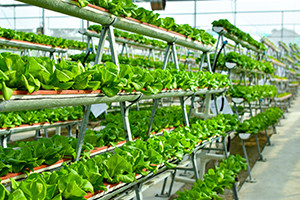Hydroponics is a technique for growing plants without the use of soil. Unlike traditional crop growing, plants cultivated through hydroponics methods and systems use small amounts of water. It is an efficient way of growing produce, increasing crop yield and food quality. We'll introduce you to the concept of hydroponics, its methods and systems as well as its advantages and disadvantages. Although plants can grow without soil, they cannot thrive without the nutrients soil offers. Without soil, how can plants get the nutrients they need? You will learn about the units of measurement of nutrients, abbreviations of elements and how to supply nutrient solutions to plants. Following that, we will teach you about the mineral content in plants, the essential elements and their function. Next, you will study how plant roots absorb water and minerals, the composition of mineral soils and how to determine the level of alkalinity or acidity in the solid using the pH scale.
Proper crop irrigation is paramount for plant growth and development and revegetates soils lacking water. We analyse effectively designed irrigation systems that ensure enough water reaches every plant in the hydroponic garden. On top of that, we will help you understand how to use growing pots and trays, substrates for starting seeds and the equipment for growing crops indoors. Managing pests in the garden is important because they cause various diseases and plant mortality so you must control them adequately. We highlight the physical, biological, chemical and cultural ways of managing pests. Upon that, you'll discover what tools and equipment are best for enhancing plant care and how to use them. Gain insight into the various rooting media used when starting new plants from seeds or cuttings.
The following section examines the process of seeding and seedling production and the best environmental condition for growing crops. You'll discover the optimum carbon dioxide concentration and temperature in which they will thrive best. Discover nutrient problems in plants, nutrient solution reagents and nutrient formulation. Due to the adverse weather, environmental temperature changes often affect plant growth. With that in mind, a greenhouse that protects plants from extreme temperatures is used to grow crops. We discuss the greenhouse environment, its benefits and how to design and construct a backyard greenhouse. Hydroponics methods can let you develop a large volume of high-quality food in areas with large populations. Are you passionate about tackling the problem of food scarcity in your neighbourhood by growing crops and improving crop yield? Enrol and start this course right away.
What You Will Learn In This Free Course
View All Learning Outcomes View Less All Alison courses are free to enrol study and complete. To successfully complete this course and become an Alison Graduate, you need to achieve 80% or higher in each course assessment. Once you have completed this course, you have the option to acquire an official , which is a great way to share your achievement with the world.
Your Alison is:
- Ideal for sharing with potential employers
- Great for your CV, professional social media profiles and job applications.
- An indication of your commitment to continuously learn, upskill & achieve high results.
- An incentive for you to continue empowering yourself through lifelong learning.
Alison offers 3 types of s for completed courses:
- Digital : a downloadable in PDF format immediately available to you when you complete your purchase.
- : a physical version of your officially branded and security-marked
All s are available to purchase through the Alison Shop. For more information on purchasing Alison , please visit our FAQs. If you decide not to purchase your Alison , you can still demonstrate your achievement by sharing your Learner Record or Learner Achievement Verification, both of which are accessible from your Account Settings.














 Avg Hours
Avg Hours CPD Accredited
CPD Accredited
 Total XP:
Total XP: 
 Knowledge & Skills You Will Learn
Knowledge & Skills You Will Learn







